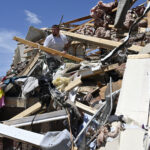Federal investigators said that audio recordings from a commuter train are missing required verbal safety checks between the engineer and the conductor in the seconds before the train collided with a freight engine, killing 25 people.
The recordings, obtained by the National Transportation Safety Board from the Metrolink dispatch center, show the engineer and conductor called out and confirmed light signals along the route, but the tapes are missing that call-and-response for the last two lights the train passed just before the fiery wreck, said Kitty Higgins, an NTSB board member.
Investigators also determined Sunday that the train failed to stop at the final red signal, which forced the train onto a track where the Union Pacific freight was traveling in the opposite direction, Higgins said at a news conference. The announcement confirmed earlier statements by Metrolink spokeswoman Denise Tyrrell, who said Saturday that the engineer ran the red signal and caused the accident.
NTSB experts are also planning to review the cell phone records of two teenagers and the engineer, who died in the crash, after the teens had told CBS2-TV that they received a text message from the engineer at 4:22 p.m. Friday. The wreck happened moments later.
Higgins said, however, that her agency was not yet ruling out any possible causes of the collision. She said usually an investigation of a train crash takes a year.
“There’s a lot of things. In any accident I’ve been involved in, it’s never one factor. I call it the perfect storm. We work hard not to jump to conclusions,” Higgins said.
The crash on Friday was America’s worst rail disaster in 15 years. In addition to the 25 people killed, 135 were injured, many critically, when the Metrolink train carrying 220 passengers barreled into a Union Pacific freight train north of Los Angeles.
Higgins said the conductor and the engineer were required to call out signals to each other as the train moved, but there was silence on the audio recordings as the train passed first a solid yellow light and then the final red beacon.
The pair had correctly called the light just prior to those two, a flashing yellow light, or approach signal.
“We don’t have any recording of a callout or confirmation for those last two signals,” she said.
She cautioned, however, that the train may have entered a dead zone where the recording was interrupted.
Higgins said the NTSB would measure the distance between points along the track on Monday.
She said investigators also wanted to speak with the conductor, who was injured, about the recording.
“He’ll be able to tell us whether he recalls the engineer calling out and him confirming those signals,” she said.
Higgins said experts still must examine whether the signal was working properly and were in the Metrolink engineer’s line of sight. Investigators will also review data to ensure the signals were fully operational.
However, she stressed that obeying signals on the track was an engineer’s responsibility at the helm of a train.
“My understanding is it is very unusual for an experienced engineer to run a red light,” she said.
Metrolink said earlier Sunday that a dispatcher tried to warn the engineer of the commuter train that he was about to collide with a freight train but the call came too late. The dispatcher reached the conductor in the rear of the train, but by then it had already crashed into the oncoming Union Pacific train, Metrolink officials said.
However, the NTSB contradicted Metrolink’s report. Higgins said that the dispatcher noticed something was wrong, but before he could contact the train, the conductor — who survived — called in to report the wreck.
Higgins said she believed the crash could have been prevented with technology that stops a train on the track when a signal is disobeyed. The technology, known as Positive Train Control, is not in place where the collision occurred.
“I believe this technology could have prevented the accident. If he ran the signal the train would have been stopped. I’ve seen it tested. It makes a difference,” she said.
Rescue crews recovered two data recorders Saturday from the Metrolink train and one data recorder and one video recorder from the freight train. The video has pictures from forward-looking cameras and the data recorders have information on speed, braking patterns and whether the horn was used.
Two days after the crash, men wearing green and orange safety vests walked up and down the tracks Sunday in an early morning fog, while others snapped pictures and climbed inside the wrecked shell of the front passenger car.
There were no new reports of fatalities from hospitals Sunday, and the scene was cleared of bodies, said Lt. Cheryl MacWillie of the county coroner’s office. Two more victims were identified, leaving only two whose names have not been released pending notification of kin.
The collision occurred on a horseshoe-shaped section of track in Chatsworth at the west end of the San Fernando Valley.
The commuter train was heading from downtown Los Angeles to Ventura County. The impact rammed the Metrolink engine backward, jamming it deep into the first passenger car.
It was the deadliest passenger train crash since Sept. 22, 1993, when Amtrak’s Sunset Limited plunged off a trestle into a bayou near Mobile, Alabama, moments after the trestle was damaged by a towboat; 47 people were killed.
Associated Press writers Thomas Watkins, Michael Blood, Daisy Nguyen, Christina Hoag, Greg Risling, Justin Pritchard, James Beltran, John Rogers, Shaya Mohajer and Gillian Flaccus contributed to this report.
Was this article valuable?
Here are more articles you may enjoy.

 Cars Are Getting Smarter. Why It Matters for Claims Professionals
Cars Are Getting Smarter. Why It Matters for Claims Professionals  Citi Reverses Course on Firing of Japan Trader Five Years On
Citi Reverses Course on Firing of Japan Trader Five Years On  Will Workers’ Comp Benefit from ‘Most-Favored-Nation’ Drug Pricing?
Will Workers’ Comp Benefit from ‘Most-Favored-Nation’ Drug Pricing?  Central US Severe Weather Outbreak Caused Billions in Damages, AccuWeather Says
Central US Severe Weather Outbreak Caused Billions in Damages, AccuWeather Says 